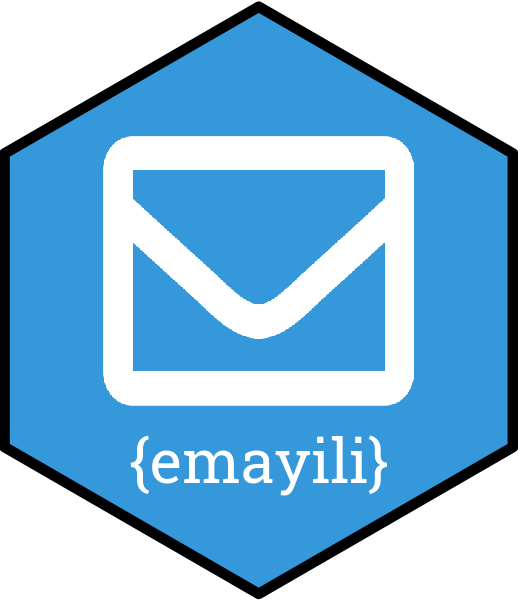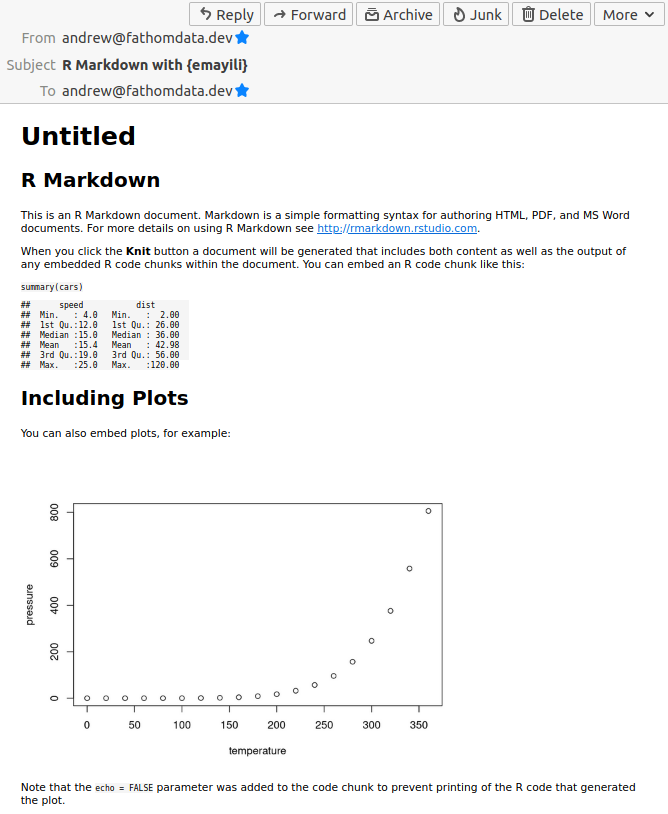

{emayili} is a package for sending emails from R. The design goals are:
The package name is an adaption of the Zulu word for email, imeyili.
The documentation for {emayili} can be found here.
Get the stable version from CRAN.
Or grab it directly from GitHub.
# Install from the master branch.
remotes::install_github("datawookie/emayili")
# Install from the development branch.
remotes::install_github("datawookie/emayili", ref = "dev")Load the library.
[1] '0.7.9'Create a message object.
The message has class envelope.
[1] "envelope"Add addresses for the sender and recipient.
There are also bcc() and reply() functions for setting the Bcc and Reply-To fields.
You can supply multiple addresses in a variety of formats:
envelope() %>% to("bob@google.com, craig@google.com, erin@gmail.com")
envelope() %>% to("bob@google.com", "craig@google.com", "erin@gmail.com")
envelope() %>% to(c("bob@google.com", "craig@google.com", "erin@gmail.com"))Add a subject.
Add a text body.
You can use html() to add an HTML body. It accepts either a vector of characters or a tagList() from {htmltools}.
Add an attachment.
You can also create the message in a single command:
email <- envelope(
to = "bob@google.com",
from = "alice@yahoo.com",
subject = "This is a plain text message!",
text = "Hello!"
)Simply printing a message displays the header information.
Date: Sun, 03 Apr 2022 16:04:25 GMT
X-Mailer: {emayili}-0.7.9
MIME-Version: 1.0
From: alice@yahoo.com
To: bob@google.com
Cc: craig@google.com
Subject: This is a plain text message!You can identify emails which have been sent using {emayili} by the presence of an X-Mailer header which includes both the package name and version.
If you want to see the complete MIME object, just convert to a string.
You can also call the print() method and specify details = TRUE.
You can set the envelope.details option to assert that the details should always be printed.
By default the results returned by most of the methods are invisible. You can make them visible via the envelope.invisible (default: TRUE).
You can use {glue} syntax to interpolate content into the body of a message.
Date: Sun, 03 Apr 2022 16:04:25 GMT
X-Mailer: {emayili}-0.7.9
MIME-Version: 1.0
Content-Type: text/plain;
charset=utf-8;
format=flowed
Content-Transfer-Encoding: 7bit
Content-MD5: nhjeY5ZYMzru+kSCGUzNKg==
Hello Alice!You can render Markdown straight into a message.
Use either plain Markdown.
envelope() %>%
# Render plain Markdown from a character vector.
render(
"Check out [`{emayili}`](https://cran.r-project.org/package=emayili)."
)Date: Sun, 03 Apr 2022 16:04:25 GMT
X-Mailer: {emayili}-0.7.9
MIME-Version: 1.0
Content-Type: text/html;
charset=utf-8
<html><body><p>Check out <a href="https://cran.r-project.org/package=emayili"><code>{emayili}</code></a>.</p></body></html>Or R Markdown.
In both cases the function will accept either a file path or a character vector containing Markdown text.

Interpolation also works with render().
When you render an R Markdown document the resulting HTML includes CSS from three sources:
{rmarkdown}.You can control which of these propagate to the message using the include_css parameter which, by default, is set to c("rmd", "bootstrap", "highlight").
🚨 Note: Gmail doesn’t like the Bootstrap CSS. If you want your styling to work on Gmail you should set include_css = c("rmd", "highlight").
You can insert extra CSS into your rendered messages.
If you are having trouble getting this to work with Gmail then it might be worthwhile taking a look at their CSS support.
Adding an inline image to an HTML message is possible. There are two ways to achieve this.
1. Base64 Encoding
First you’ll need to Base64 encode the image.
Then create the HTML message body.
And finally add it to the email.
Note: It’s important that you specify the appropriate media type (image/jpeg for JPEG and image/png for PNG).
2. Using a CID
Unfortunately some mail clients (like Gmail) will not display Base64 encoded images. In this case using a CID is a working alternative.
First create the message body which references an image by CID.
Then attach the image and specify the cid argument.
Create a SMTP server object and send the message.
smtp <- server(
host = "smtp.gmail.com",
port = 465,
username = "bob@gmail.com",
password = "bd40ef6d4a9413de9c1318a65cbae5d7"
)
smtp(email, verbose = TRUE)To see the guts of the message as passed to the SMTP server:
If you’re trying to send email with a host that uses the STARTTLS security protocol (like Google Mail, Yahoo! or AOL), then it will most probably be blocked due to insufficient security. In order to circumvent this, you can grant access to less secure apps. See the links below for specifics:
The following (draft) standards documents relate to emails:
There is a selection of other R packages which also send emails:
You can find the test coverage report at Codecov. For development purposes it’s more convenient to use the {covr} package.
Generate a coverage report.
library(covr)
# Tests that are skipped on CRAN should still be included in coverage report.
#
Sys.setenv(NOT_CRAN = "true")
report()Calculate test coverage.
Coverage statistics as a data frame.
Show lines without coverage.
Check spelling.
Use rhub to test on various platforms.
# Check for a specific platform.
#
rhub::check(platform = "debian-gcc-devel")
rhub::check_on_windows(check_args = "--force-multiarch")
rhub::check_on_solaris()
# Check on a bunch of platforms.
#
rhub::check_for_cran()
# Check on important platforms.
#
rhub::check_for_cran(platforms = c(
"debian-gcc-release",
"ubuntu-gcc-release",
"macos-m1-bigsur-release",
"windows-x86_64-release",
NULL
))